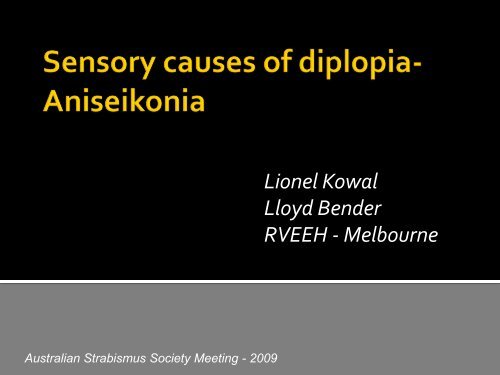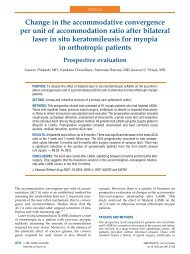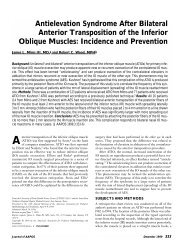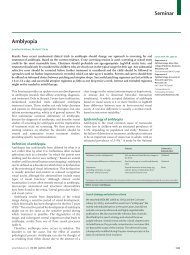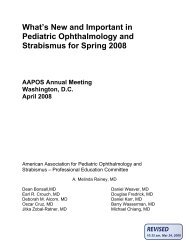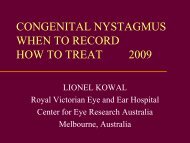Sensory causes of diplopia- Aniseikonia - The Private Eye Clinic
Sensory causes of diplopia- Aniseikonia - The Private Eye Clinic
Sensory causes of diplopia- Aniseikonia - The Private Eye Clinic
Create successful ePaper yourself
Turn your PDF publications into a flip-book with our unique Google optimized e-Paper software.
Australian Strabismus Society Meeting - 2009<br />
Lionel Kowal<br />
Lloyd Bender<br />
RVEEH - Melbourne
• Motor and sensory<br />
• <strong>Aniseikonia</strong> – barrier to sensory fusion<br />
• Motor fusion impaired by sensory defect<br />
Metamorphopsia<br />
Field defect<br />
<strong>Aniseikonia</strong>
ASK EVERY PATIENT WHOSE DIPLOPIA IS<br />
NOT EASILY COMPENSATED FOR WITH<br />
PRISM:<br />
Is the image seen by the RE<br />
• Larger / smaller than the LE<br />
• <strong>The</strong> same shape as LE<br />
• Paler / darker than LE<br />
• Tilted [ torsion]
Two main clinical <strong>causes</strong> <strong>of</strong> <strong>Aniseikonia</strong><br />
• Macular pathology<br />
• Anisometropia<br />
1% <strong>of</strong> aniseikoniaper<br />
DS <strong>of</strong> anisometropia
• Free Space Estimation<br />
• Space Eikonometer (Stereoscopic method)<br />
• Awaya Test (Direct Comparison Method)<br />
MEASUREMENT ARTEFACT - each technique<br />
can give a VERY different answer
•Which one is bigger<br />
•Does it look like an ‘E’ should<br />
•Are all parts <strong>of</strong> it bigger [metamorphopsia]<br />
•Is the ‘E’ tilted<br />
•If a bar <strong>of</strong> the ‘E’ is worth 20%, how much bigger is it<br />
Also check with BD<br />
prism in front <strong>of</strong> other<br />
eye - prisms can also<br />
cause magnification
Use R-G glasses.<br />
Find the pair <strong>of</strong> semi-circles where the<br />
difference in size compensates for the<br />
patient’s aniseikonia
• 12 patients<br />
• Aged 29-86<br />
• M:F 9:3
• 11<br />
• 1<br />
• 9<br />
• 4<br />
3 ERM<br />
Diplopia<br />
Wobbling <strong>of</strong> words<br />
Anisometropia<br />
Macular <strong>causes</strong><br />
1 Macular hole
• 11/12 Reported aniseikonia<br />
• <strong>The</strong> least amount <strong>of</strong> aniseikonia causing<br />
disruption <strong>of</strong> fusion was 2%<br />
• Largest amount <strong>of</strong> aniseikonia was 20 %<br />
• Average 6.4% (Mode 5%)
• 10/12 had measurable stereopsis<br />
• Range - ‘Fly’ to 50”<br />
• No relationship between stereopsis and<br />
degree <strong>of</strong> aniseikonia
• 8/12 - vertical deviation<br />
vertical fusion is more fragile than horizontal <br />
• 6/12 - horizontal deviations<br />
• 2/12 - exophoriawith poor fusion range
• Increase front base curve<br />
• Increase central thickness<br />
• Decrease BVD ( - lens)<br />
• Increase refractive index<br />
• Size lenses<br />
….<strong>of</strong>ten successful!
• 5 - modified spectacles + prisms<br />
• 1 - contact lenses<br />
• 1 - reduced prescription <strong>of</strong> near add on one<br />
lens<br />
• 1 - telescopic lenses (+ve CL and –ve<br />
spectacle lens) 20% ANISEIKONIA
• 2 - surgery for exotropia<br />
• 1 - declined treatment<br />
• 1 - failed CL - referred for size lenses
• In most patients, aniseikonia precipitates<br />
small angle strabismus due to loss <strong>of</strong> sensory<br />
fusion which in turn impairs motor fusion<br />
• Compensation for the strabismus with prisms<br />
along with lenses modified to compensate for<br />
the aniseikonia worked in 5/7 optically<br />
corrected patients
• 2/27: <strong>diplopia</strong><br />
• Measured stereo, motor fusion & VA.<br />
• Stereo & total motor fusion ranges reduced<br />
• After successful surgery, stereo function, VA<br />
& motor fusion improved mainly in those<br />
with shorter duration <strong>of</strong> symptoms [esp< 18mo]<br />
• Stereo function improved mainly in those<br />
with better preoperative stereo<br />
Ophthalmology November 2008
• Probably rare<br />
• Always unrecognised by referring<br />
practitioner<br />
• Need to ask about it - pt always knows but<br />
needs to be asked the right question!<br />
• Often fixable with prisms and aniseikonic<br />
modifications


